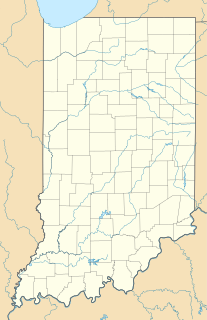
Portland–Troutdale Airport is a public use airport located 10 nautical miles east of the central business district of Portland, in Multnomah County, Oregon, United States. Also known as Troutdale Airport, it is located in Troutdale. It is one of four airports in the Portland metropolitan area owned and operated by the Port of Portland. It is included in the Federal Aviation Administration (FAA) National Plan of Integrated Airport Systems for 2017–2021, in which it is categorized as a regional general aviation facility.

Liberal Mid-America Regional Airport is two miles west of Liberal, in Seward County, Kansas. It is used for general aviation and was at one point subsidized by the Essential Air Service program. Formerly Liberal Municipal Airport, it hosts the Mid-America Air Museum.

Wichita Falls Regional Airport is a public and military use airport six miles north of Wichita Falls in Wichita County, Texas. Its runways and taxiways are shared with Sheppard Air Force Base; most operations are military, but American Eagle flies to Dallas-Fort Worth International Airport.

Lima Allen County Airport is a public use airport located five nautical miles (9 km) southeast of the central business district of Lima, a city in Allen County, Ohio, United States. It is owned by the Allen County Regional Airport Authority.

Fulton County Airport is two miles east of Rochester, in Fulton County, Indiana. It is owned by the Fulton County Airport Authority.
Lawrence Municipal Airport is three miles north of Lawrence, in Douglas County, Kansas.
Cessna Aircraft Field is a public use airport located four nautical miles southeast of the central business district of Wichita, in Sedgwick County, Kansas, United States. It is privately owned by the Cessna Aircraft Company.
Elkhart–Morton County Airport is a county-owned public-use airport located one nautical mile (1.85 km) east of the central business district of Elkhart, a city in Morton County, Kansas, United States.
Emporia Municipal Airport is a city-owned public-use airport, located five miles south of Emporia, in Lyon County, Kansas.
Hill City Municipal Airport is a mile northeast of Hill City, in Graham County, Kansas.

Hutchinson Municipal Airport is a city-owned public airport three miles east of Hutchinson, in Reno County, Kansas.

Porter County Regional Airport is a public use airport one nautical mile (1.8 km) southeast of the central business district of Valparaiso, a city in Porter County, Indiana, United States. The Porter County Municipal Airport Authority owns the airport.

Michigan City Municipal Airport is a public use airport located three nautical miles east of the central business district of Michigan City, in LaPorte County, Indiana, United States. The airport is publicly owned by the Michigan City Board of Aviation Commissioners.

Newton City-County Airport is three miles east of Newton, in Harvey County, Kansas. It is owned by the City of Newton and Harvey County.

Baker City Municipal Airport is three miles north of Baker City, in Baker County, Oregon. The National Plan of Integrated Airport Systems for 2011–2015 categorized it as a general aviation facility.

Strother Field is a public airport located in Cowley County, Kansas, United States. It is located five nautical miles southwest of the central business district of Winfield and north of Arkansas City. The airport is jointly owned by both cities. This airport is included in the National Plan of Integrated Airport Systems for 2011–2015, which categorized it as a general aviation facility.

Independence Municipal Airport is six miles southwest of Independence, in Montgomery County, Kansas. The National Plan of Integrated Airport Systems for 2011–2015 categorized it a general aviation facility.

Ankeny Regional Airport is a public airport located one mile (2 km) southeast of the central business district of Ankeny, a city in Polk County, Iowa, United States. It is owned by the Polk County Aviation Authority.

Danville Regional Airport is three miles east of Danville, in southern Virginia. The Federal Aviation Administration (FAA) National Plan of Integrated Airport Systems for 2017–2021 categorized it as a regional general aviation facility.

Alva Regional Airport is a city-owned, public-use airport located two nautical miles (4 km) south of the central business district of Alva, a city in Woods County, Oklahoma, United States. It is included in the National Plan of Integrated Airport Systems for 2011–2015, which categorized it as a general aviation facility.




















